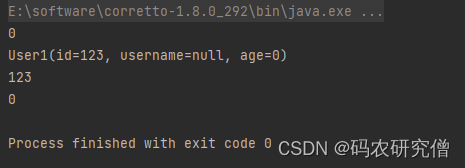详解Java中@Accessors注解(全)
2024-01-08 07:30:30
前言
关于该注解的学习,主要来源项目中涉及,对此进行查漏补缺
@Accessors 注解通常用于简化实体类的代码,使其更加简洁和易读。
1. 概念
@Accessors 是 Lombok(一种Java库)提供的注解之一,用于自动生成 getter 和 setter 方法,并可以配置一些属性。
以下是关于 @Accessors 注解的详细解释
常用属性:
- fluent:如果设置为 true,生成的 getter 方法会移除 get 前缀,setter 方法移除 set 前缀。
- chain:如果设置为 true,生成的 setter 方法会返回当前对象,支持方法链调用。
- prefix:为生成的 getter 和 setter 方法添加指定前缀。
类似如下例子:
import lombok.AccessLevel;
import lombok.Setter;
import lombok.ToString;
import lombok.experimental.Accessors;
@ToString
@Accessors(chain = true, fluent = true)
public class Example {
@Setter(AccessLevel.PROTECTED)
private String name;
private int age;
}
在上面的例子中,@Accessors 注解配置了 chain = true 和 fluent = true,表示生成的 setter 方法支持方法链调用,并移除了 get 和 set 前缀。
通过源码也可看出其配置的属性:
/**
* A container for settings for the generation of getters and setters.
* <p>
* Complete documentation is found at <a href="https://projectlombok.org/features/experimental/Accessors">the project lombok features page for @Accessors</a>.
* <p>
* Using this annotation does nothing by itself; an annotation that makes lombok generate getters and setters,
* such as {@link lombok.Setter} or {@link lombok.Data} is also required.
*/
@Target({ElementType.TYPE, ElementType.FIELD})
@Retention(RetentionPolicy.SOURCE)
public @interface Accessors {
/**
* If true, accessors will be named after the field and not include a {@code get} or {@code set}
* prefix. If true and {@code chain} is omitted, {@code chain} defaults to {@code true}.
* <strong>default: false</strong>
*
* @return Whether or not to make fluent methods (named {@code fieldName()}, not for example {@code setFieldName}).
*/
boolean fluent() default false;
/**
* If true, setters return {@code this} instead of {@code void}.
* <strong>default: false</strong>, unless {@code fluent=true}, then <strong>default: true</strong>
*
* @return Whether or not setters should return themselves (chaining) or {@code void} (no chaining).
*/
boolean chain() default false;
/**
* If present, only fields with any of the stated prefixes are given the getter/setter treatment.
* Note that a prefix only counts if the next character is NOT a lowercase character or the last
* letter of the prefix is not a letter (for instance an underscore). If multiple fields
* all turn into the same name when the prefix is stripped, an error will be generated.
*
* @return If you are in the habit of prefixing your fields (for example, you name them {@code fFieldName}, specify such prefixes here).
*/
String[] prefix() default {};
}
2. 属性
默认fluent、chain 都是false
对于false,其设定的值跟往常差不多!
举例如下:(主要为了区分fluent、chain以及prefix三个属性)
@Data
//@AllArgsConstructor
//@NoArgsConstructor
@TableName("test_user1")
@Accessors(chain = false,fluent = false)
public class User1 {
@TableId(value = "id", type = IdType.AUTO)
private int xxId;
private String yyUserName;
private int zzAge;
// 其他字段...
public static void main(String[] args) {
User1 user1 = new User1();
user1.setXxId(123);
user1.setYyUserName("manong");
user1.setZzAge(123);
System.out.println(user1); // User1(xxId=123, yyUserName=manong, zzAge=123)
System.out.println(user1.getZzAge()); // 123
}
}
截图如下:

2.1 fluent属性
为了方便测试,原先fluent默认就是false,当修改为true的时候:
@Data
@TableName("test_user1")
@Accessors(fluent = true)
public class User1 {
@TableId(value = "id", type = IdType.AUTO)
private int id;
private String username;
private int age;
// 其他字段...
public static void main(String[] args) {
User1 user1 = new User1();
System.out.println(user1.id()); // 这个返回的值是int值,因为id为int类型
System.out.println(user1.id(123)); // 这个返回的对象值是类
System.out.println(user1.id()); // 再次看看id的属性为,123
System.out.println(user1.age()); // 查看其age属性,发现为0
}
}
截图如下:

对应的属性有如下:
- 返回属性值
- 返回对象
可以通过得到对象再去检查其他的属性:

2.2 chain属性
chain的区别在于可以链式设定值!
代码如下:
@Data
@TableName("test_user1")
@Accessors(chain = true)
public class User1 {
@TableId(value = "id", type = IdType.AUTO)
private int id;
private String username;
private int age;
// 其他字段...
public static void main(String[] args) {
User1 user1 = new User1();
// System.out.println(user1.setId(123)); // 返回对象
user1.setAge(123).setUsername("manong");
System.out.println(user1); // User1(id=0, username=manong, age=123)
System.out.println(user1.getAge()); // 123
User1 user2 = new User1().setAge(333).setUsername("yanjiuseng");
System.out.println(user2); // User1(id=0, username=yanjiuseng, age=333)
}
}
截图如下:

2.3 prefix属性
注意属性中的前缀后要开头大写!此处的前缀必须为string类型
比如id属性,为了加一个前缀xx,则属性值应该为xxId,如果为xxid代码会错!
代码如下:
@Data
@TableName("test_user1")
@Accessors(prefix = {"xx","yy","zz"})
public class User1 {
@TableId(value = "id", type = IdType.AUTO)
private int xxId;
private String yyUserName;
private int zzAge;
// 其他字段...
public static void main(String[] args) {
User1 user1 = new User1();
user1.setId(123);
user1.setUserName("manong");
user1.setAge(123);
System.out.println(user1); // User1(xxId=123, yyUserName=manong, zzAge=123)
System.out.println(user1.getAge()); // 123
}
}
截图如下:

文章来源:https://blog.csdn.net/weixin_47872288/article/details/135434341
本文来自互联网用户投稿,该文观点仅代表作者本人,不代表本站立场。本站仅提供信息存储空间服务,不拥有所有权,不承担相关法律责任。 如若内容造成侵权/违法违规/事实不符,请联系我的编程经验分享网邮箱:veading@qq.com进行投诉反馈,一经查实,立即删除!
本文来自互联网用户投稿,该文观点仅代表作者本人,不代表本站立场。本站仅提供信息存储空间服务,不拥有所有权,不承担相关法律责任。 如若内容造成侵权/违法违规/事实不符,请联系我的编程经验分享网邮箱:veading@qq.com进行投诉反馈,一经查实,立即删除!